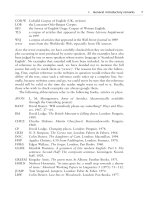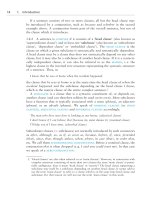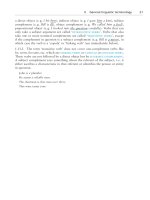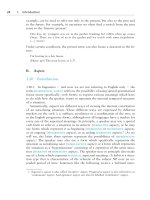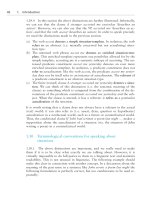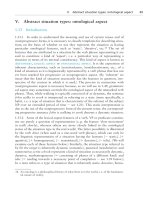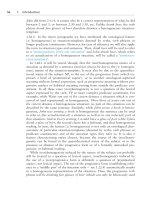The grammar of the english verb phrase part 30 docx
Bạn đang xem bản rút gọn của tài liệu. Xem và tải ngay bản đầy đủ của tài liệu tại đây (74.75 KB, 7 trang )
196 4. The absolute past tense
4.2 Bygone situations: ‘W-bygone’ vs ‘T-bygone’
A situation is W-bygone if it is completely over at t
0
. Both I did it and I have done it
refer to W-bygone situations. A situation is T-bygone if the situation time is represented
as bygone by the tense form used.
The fact that a situation time is represented as T-bygone does not always mean that
the full situation has to be over at t
0
. Thus, it does not follow from Five minutes ago
Meg was washing an elephant that the washing must have stopped before t
0
.
4.2.1 We will refer to a situation which is completely over at t
0
in the actual
world (or in the fictional world referred to) as a
W-bygone situation. Since
the reference is to a real-world situation, a W-bygone situation is always a ‘full
situation’ Ϫ see 2.12.
The label ‘past situation’ will not be used in this sense, because bygone
situations may under certain conditions be located in the pre-present (I have
closed the door) rather than in the past (I closed the door). By ‘past situation’
we will mean a W-bygone situation whose situation time is located in a past
domain. The name ‘finished situation’ is not suitable as an alternative to ‘W-
bygone situation’ either, because ‘finished’ is applicable to telic situations
only Ϫ see 1.39.6 Ϫ whereas W-bygone situations may be referred to by VPs
which are either telic (John told me a story) or atelic (John was a nice guy; I
was reading poetry).
4.2.2 A situation whose situation time is located completely before t
0
by a
tense is a
T-bygone situation. Since the reference is to how a situation is lo-
cated in time by a tense, a T-bygone situation is a ‘predicated situation’ rather
than a ‘full situation’ Ϫ see 2.12. In ten minutes ago John was working in the
garden, the predicated situation (i. e. that portion of the full situation that
coincides with the time indicated by the adverbial) is completely over at t
0
(i. e.
T-bygone), but the full situation may still be continuing.
4.2.3 For ease of reference, we will speak of ‘
bygone’ situations rather than
‘W-bygone’ or ‘T-bygone’ situations when it is not necessary to make the dis-
tinction explicitly or when the distinction is difficult to make. An example of
the latter possibility is when we make statements like the following:
Under certain conditions either the past tense or the present perfect can be used to
locate a bygone situation in time. (What a tense locates in time is the time of a
predicated situation, i. e. a ‘situation time’, not the time of a full situation. In this
sense the preterite represents the situation as T-bygone. At the same time, however,
I. Introduction 197
the use of the past tense entails (if the sentence is bounded) or implicates (if the
sentence is nonbounded Ϫ see 1.44.2) that the full situation is over at t
0
. The un-
marked W-interpretation of a sentence in the past tense is therefore that the situation
is W-bygone.)
4.2.4 It is often claimed that a situation that is described in the past tense
cannot be still actualizing at t
0
. That this is not correct appears from examples
like the following:
[“Where is John?” Ϫ “I don’t know. But look in the kitchen]. He was there two
minutes ago. [Perhaps he is still there.”]
The use of the past tense here means no more than that the speaker claims that
two minutes ago it was the case that the static situation was (then) holding.
This claim does not exclude the possibility that the situation was actualizing
at other times too, nor that it is still actualizing at t
0
. In other words, when
uttering He was there two minutes ago the speaker just focuses on that part of
the situation that is simultaneous with the ‘anchor time’ (see 4.1) indicated by
two minutes ago. He does not make any claims about other parts of the situa-
tion or about the situation as a whole. In technical terms, what is located in
the past is not the time of the full situation but the situation time (the time of
the predicated situation), which is punctual here because it is contained in the
punctual Adv-time denoted by two minutes ago. (‘Containment’ here means
‘coincidence’ Ϫ see 2.23.1.) In this case the situation time is represented as past
(and hence as T-bygone), but this does not exclude the possibility that the full
situation is not W-bygone.
4.3 The implicature of discontinuation
Though the fact that a situation time is represented as T-bygone does not always mean
that the full situation has to be over at t
0
, homogeneous clauses in the past tense do
implicate this if they do not form part of a stretch of discourse about the past.
4.3.1 If the full situation is homogeneous (nonbounded Ϫ see 1.45) and there
is no adverbial or contextual indication that the situation time (ϭ the time of
the predicated situation) is not the time of the full situation, the absolute past
tense implicates that the full situation is completely over at t
0
Ϫ see 1.44.
There was somebody in the kitchen. (implicates that this is no longer the case)
198 4. The absolute past tense
This implicature of discontinuation follows from the Gricean Maxim of
Relation (Relevance).
1
Unless they form part of a stretch of discourse about
the past, statements about the present are more relevant than statements about
the past. It follows that a situation that includes t
0
should be located in the
present, not in the past. Hence, if the speaker uses the past tense, this is inter-
preted as a sign that he cannot locate the situation in the present, i. e. that the
reference is to a situation which is completely over.
I lived in a flat for ten years. (implicates that I am not living in a flat any more)
John was an excellent centre forward. (implicates that this is no longer the case, e. g.
because John’s capacities have diminished as a result of age or injuries, or because
John does not play football any more, or now plays as goalkeeper, or as centre
forward for another team, etc.)
As is typical of implicatures, this interpretation of discontinued full situation
can be cancelled or blocked (ϭ prevented from arising) by the context:
[“If you can’t bear Norman’s habits, why did you move in with him?”] Ϫ “I liked
him. Still do, for that matter. [It’s just his habits I can’t stand.”] (The implicature of
discontinuation evoked by I liked him is cancelled by the addition of Still do.)
Compare:
When he was a baby, Sam had white hair. (suggests that he no longer has white hair)
When he was a baby, Sam already had red hair. (It is difficult for the implicature of
discontinuation to arise because already tends to block it.)
When he was a baby, Sam had white hair. [Now he’s eleven, and his hair is still
white. It gets him noticed.] (The implicature of discontinuation is cancelled by the
second sentence.)
4.3.2 It is important to note that if a situation is linguistically represented as
L-bounded (rather than merely pragmatically interpreted as W-bounded be-
1. An aspect of meaning (or rather interpretation) is an ‘implicature’ (or is ‘implicated’) if
it does not follow from the semantics of the construction or the lexical items (ϭ words)
used but rather from the context, from pragmatic knowledge of the world, or from
“principles of conversation” which are conventionally observed by “cooperative” speak-
ers and hearers (Grice 1975). For example, Clear away the glasses! is by implicature
interpreted (and meant to be interpreted) as an instruction to clear away all the glasses
that are relevant in a particular context. However, like all implicatures induced by con-
versational principles, this aspect of meaning (the ϭ ‘all the’) can be cancelled. This is
the case, for example, in Clear away the glasses, except those that are not empty, and
also in The person who cleared away the glasses overlooked those on the window-sill.
The most relevant principles of conversation are discussed in Grice (1975), where they
are called ‘Maxims’ (hence the term ‘Gricean Maxims’). The ‘Maxim of Relation’ (now
more often referred to as the Maxim of Relevance) stipulates that a cooperative speaker
will only say things that are relevant at the given point of the discourse.
I. Introduction 199
cause of the above mentioned implicature), that situation is by definition re-
ferred to as a whole. In that case the situation time coincides with the time of
the full situation (see 2.12.1), so that locating the situation time in the past
time-sphere (by means of the ‘absolute past tense’ Ϫ see 2.44) is tantamount to
locating the full situation in the past. In such sentences the idea of discontinued
situation is more than pragmatically implicated: it is linguistically asserted.
[“How far did John walk?”] Ϫ “He walked three and a half miles.” (The combina-
tion of the telic VP walk three and a half miles and nonprogressive aspect results in
a bounded representation Ϫ see 1.49.1. Because of this, the situation time is interpre-
ted as being the time of the full situation Ϫ see 2.12.2. Since the past tense locates
the situation time in the past, it follows that the entire situation is interpreted as
lying in the past, i. e. that the situation of John walking three and a half miles cannot
be interpreted as continuing into the present.)
I wrote him a letter last night. (similar)
4.4 The nonprogressive past vs the progressive past
As noted in 1.22.4, the difference between the nonprogressive form and the
progressive form is not a distinction that has to do with tense but an aspectual
distinction: the main reason for using these forms is to express ‘nonprogressive’
and ‘progressive’ aspect, respectively (see 1.21Ϫ22 for an explanation of these
terms.) Thus, both walked and was walking are past tense forms. Because these
verb forms also express the absence or presence of progressive aspect, we will
call them examples of the ‘
nonprogressive past’ and the ‘progressive past’,
respectively, wherever this aspectual distinction is relevant.
It was noted in 3.8Ϫ9 that the nonprogressive present and the progressive
present have a special shift-of-perspective use in which they establish a future
domain rather than a present one: He {leaves / is leaving} tomorrow. This
special use has a past counterpart, but we do not need to be concerned with it
in the present discussion of the absolute past tense, because past tenses express-
ing posteriority can only be used as relative tenses, as in He said he {left / was
leaving} the next day, where (from a purely temporal point of view) left and
was leaving are equivalent to would leave, which is a relative tense form. (This
is not to say that this use of the past tense is restricted to subordinate clauses.
Under certain conditions it is also found in independent clauses:)
[John was very nervous.] The game was starting in a few minutes now. (free indi-
rect speech)
200 4. The absolute past tense
II. Uses of the absolute past tense
Needless to say, in this volume we only deal with the nonmodal uses of the
past tense.
The situation time of a bygone situation can in principle be located either
in the pre-present zone (by the use of a present perfect form) or in the past
time-sphere (by the use of the past tense). As will be further explained in
chapter 7, the speaker chooses the former possibility if he is somehow thinking
of t
0
while referring to the bygone situation; otherwise he uses the past tense.
In the latter case he is not concerned with NOW but with THEN. In what
follows we will investigate the factors that can induce or reveal the speaker’s
concern with THEN.
4.5 Concern with THEN is clear from the context
A speaker using the absolute past tense is concerned with a past time (THEN) rather
than with the present (NOW). This concern is sometimes clear from the context.
The speaker’s concern with a past time is obvious when the sentence forms
part of a text (or stretch of spoken discourse) which only uses past time-sphere
tenses (i. e. the past tense, the past perfect, the conditional tense or the condi-
tional perfect). In this case the ‘discourse topic’ to which the bygone situations
relate clearly concerns THEN rather than NOW. (By ‘discourse topic’ we mean
what a stretch of discourse, i. e. spoken or written text, is about.)
We embarked at dawn, when it was still relatively dark. None of us said a word.
We all felt nervous and afraid.
[“How did you get here so fast?”] Ϫ “I managed to catch a bus five minutes after
you rang, then there was a train due as I arrived at the station. I just had time to
buy a ticket and I jumped onto the train as the doors were closing. When I got to
Brussels I was really lucky because the tube trains had been running late, but one
arrived just as I got to the platform, and then when I got out at your tube station I
ran all the way here.” (Though the reply as a whole is an explanation of the speaker’s
unexpectedly early presence at speech time, the speaker uttering the reply is essen-
tially concerned with what he had to do to manage to reach the addressee so quickly.
In each of the clauses in the past tense, the speaker is concerned with one particular
situation forming part of the past sequence of situations resulting in his early ar-
rival.)
II. Uses of the absolute past tense 201
4.6 The past tense used to focus on the ‘when?’ of the
situation
For a good temporal understanding of a clause in the absolute past tense the minimal
requirement is that the hearer be aware of the existence of a specific past time at which
the situation actualized. For a full temporal interpretation it is often necessary that that
specific time should also be definite (identifiable) to the hearer. Past times may be
identifiable in various ways. In each case the use of the past tense (rather than the
present perfect) is obligatory.
4.6.1 The speaker will use the past tense if he is concerned with the question
of when a bygone situation actualized. This is automatically the case if the
sentence involves an adverbial referring to a specific past time, such as last
week, a week ago, then, the other day, yesterday, at the time, in 1989, on
Tuesday, earlier this summer
John {left / *has left} his wife last week.
It was then that things {started / *have started} going wrong.
4.6.2 Questions beginning with when normally use the past tense rather than
the present perfect, because When …? normally means that the speaker is con-
cerned with THEN rather than NOW:
{When / at what time} {did those incidents take place / *have those incidents
taken place}?
When {did he arrive / *has he arrived}?
When {did you see / *have you seen} her house for the first time?
These examples should be compared with the following:
[“I don’t believe you. You always lie to me.” — “That’s not true.] When have I ever
lied to you?”
In this example, the message is that there do not exist any occasions on which
the speaker lied to the addressee. The question does ask ‘when?’, because one
could answer ‘last week’, but it is also rhetorical since it assumes that the
addressee cannot provide such an instance, and it thus means ‘I don’t believe
that you can cite any instance Ϫ I don’t believe that one exists.’ This means
that the speaker is not concerned with the THEN of a particular situation or
set of situations but with the question whether the kind of situation referred
to has or has not actualized (in a period leading up to t
0
). This kind of meaning
is typically expressed by the present perfect Ϫ see 6.5.4.
202 4. The absolute past tense
4.6.3 For a full temporal understanding of a clause using the past tense to
focus on a particular past time it is usually necessary that the time in question
should be identifiable to the hearer, or at least that the hearer should be famil-
iar with the existence of such a time. Out of context, a sentence like Bill ran
away is rather pointless from a communicative point of view because the hearer
does not know what time or occasion the speaker is referring to. This means
that a speaker using the past tense has a specific past time in mind. (As noted
in 4.1, this ‘anchor time’ need not be definite in the technical sense of the word.
The time referred to by the past tense in We don’t know when this pyramid
was built is specific but not definite, i. e. not assumed to be identifiable to the
hearer. The same is true in past tense sentences introduced by indefinite adver-
bials like once upon a time, one winter morning, a long time ago, etc. Still, in
most cases the specific past anchor time is also definite.)
There is a similarity here between the use of the preterite and the use of a
definite NP. If used in isolation, a sentence like Did the man water the plants?
presupposes some shared knowledge. To fully understand this sentence, the
hearer must check his memory stock, not only for suitable referents for the
NPs the man and the plants but also for a suitable occasion (time) for the
situation to have taken place. Similarly, a question like Did John lock the door?
cannot be answered with Yes or No if it is not clear to the addressee what time
is referred to as the time at which John may or may not have locked the door.
It should also be noticed that Mary did not lock the door is not equivalent to
Mary never locked the door: unlike the latter sentence, Mary did not lock the
door asserts that Mary did not lock the door on some specific past occasion.
As noted in 4.1, the semantics of the past tense is such that it tells us no
more than that the situation referred to is located in the past time-sphere.
Further temporal information can be given in the form of a time adverbial,
whether definite (two years ago, just before Bill came in) or indefinite (some
years ago). However, it may also be deducible from the context or from prag-
matic knowledge. The following are some typical examples of this.
(a) Place adverbials may imply a past time, viz. the time when the relevant
person or entity was at the place in question.
I knew him in the army. (ϭ when I was in the army)
I met her at a conference in Oxford. (ϭ when we were at a conference in Oxford)
[I know he had the book before it was published.] I sent a proof copy to him in
Zimbabwe. (ϭ when he was in Zimbabwe or when I was in Zimbabwe)
Place adverbials of this kind offer sufficient information for the hearer to be
able to deduce the temporal location of the situation in the past. (This informa-
tion reveals the speaker’s focus on a past THEN, even though it may not be
very precise. As with other indications of the temporal location of a past situa-


